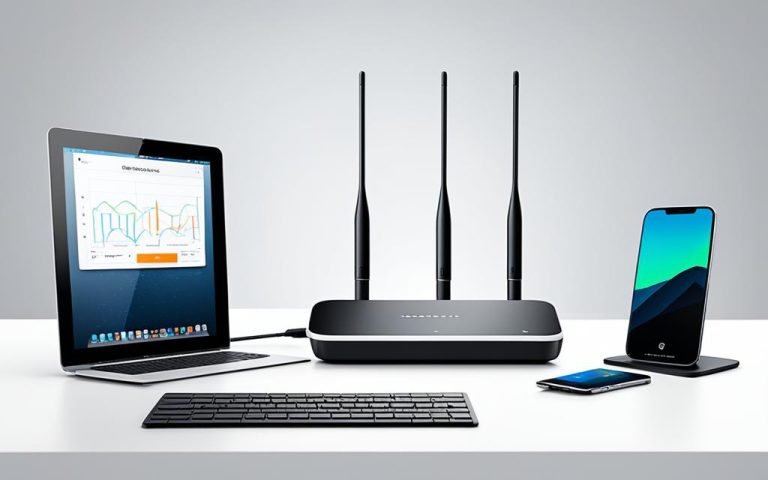In device-rich environments, such as smart homes, multiple PAN (Personal Area Network) protocols are used for communication between devices. However, the coexistence of these protocols can present challenges due to interference and poor isolation between devices. To ensure seamless integration and optimal performance, methods, apparatuses, and systems have been developed to manage the coexistence of multiple transceiver devices. These solutions involve component layout strategies, bypass circuitry, and control signals for prioritizing transmission access. By implementing these techniques, the impact of poorly isolated transceivers is reduced, resulting in improved communications performance and protection of sensitive device components.
Importance of Coexistence in Device-Rich Environments
In device-rich environments, such as smart homes or commercial buildings, a wide variety of devices are interconnected to create a network of smart systems. These devices include smart thermostats, security systems, lighting controls, and more. Each device may use different PAN protocols for communication, such as Bluetooth, Zigbee, or Z-Wave. To ensure that these devices can coexist and communicate effectively, it is essential to manage the coexistence of multiple PAN protocols.
Without proper coexistence management, interference and poor performance can occur, resulting in degraded user experience and potential damage to device components.
The Challenges of Device-Rich Environments
In the ever-expanding world of smart devices, coexistence is crucial for seamless integration and optimal performance. With the proliferation of device-rich environments, the number of interconnected devices continues to grow. Each device operates on its own PAN protocol, adding complexity and the potential for interference. Without effective coexistence management, these environments can experience communication breakdowns, decreased performance, and even system failures. The importance of coexistence cannot be overstated in ensuring reliable and efficient operation.
“Proper coexistence management is the key to unlock the full potential of device-rich environments, enabling seamless communication and maximizing the benefits of multiple PAN protocols.”
Maximizing Efficiency through Coexistence Management
To address the challenges posed by device-rich environments, coexistence management strategies are implemented. These strategies focus on minimizing interference and optimizing performance across devices with varying PAN protocols. They involve careful consideration of component layout, bypass circuitry, and the use of control signals.
By strategically arranging components within devices, isolation between transceivers can be improved, reducing the risk of interference. Bypass circuitry allows for the direct coupling of antennas to transceivers, bypassing amplifiers when interference is detected. Control signals prioritize transmission access, ensuring devices can communicate without interruption.
The implementation of these strategies not only enhances communication but also safeguards sensitive device components from potential damage caused by interference. Coexistence management maximizes efficiency, enabling device-rich environments to function harmoniously.
The Role of Effective Coexistence
Effective coexistence management in device-rich environments offers numerous benefits. It ensures reliable communication, minimizing the risk of data loss and increasing the overall performance of the network. By reducing interference, it creates a seamless user experience, preventing disruptions and enhancing user satisfaction.
Moreover, effective coexistence management protects device components from potentially harmful interference, prolonging their lifespan and reducing the need for costly repairs or replacements. This proactive approach not only saves resources but also instills confidence in the reliability and longevity of device-rich environments.
When managed effectively, coexistence enhances the scalability of device-rich environments. As more devices are integrated into the network, proper coexistence ensures that communication remains efficient, regardless of the number of devices or the complexity of the system.
The Future of Coexistence Management
The evolution of device-rich environments presents both opportunities and challenges for coexistence management. As the Internet of Things (IoT) continues to expand, the number of interconnected devices is expected to skyrocket, exacerbating the potential for interference. Future considerations include the development of best practices for performance evaluation, the contribution of IoT-related protocols being developed within the IETF, and speculative research into the design of high-layer protocols that allow networks to actively coordinate their access to the shared channel.
By continuously advancing coexistence management techniques and staying abreast of emerging technologies, we can meet the evolving needs of device-rich environments and ensure the seamless integration and optimal performance of multiple PAN protocols.
Strategies for Coexistence Management
Several strategies have been developed to manage the coexistence of multiple PAN protocols in device-rich environments. These strategies incorporate component layout strategies, bypass circuitry, and the use of control signals for prioritizing transmission access.
Component layout strategies involve carefully designing the arrangement of components within a device to improve isolation between transceivers and reduce interference. By optimizing the physical layout, the impact of poorly isolated transceivers can be mitigated, ensuring efficient coexistence of PAN protocols.
Bypass circuitry is another effective strategy for coexistence management. It enables direct coupling of antennas to transceivers, bypassing amplifiers when interference is detected. This bypass helps in minimizing the impact of interference on the overall performance of the device network.
Control signals also play a vital role in coexistence management. Through these signals, transmission access can be prioritized, allowing devices to communicate without interference. By intelligently managing access, the potential for conflict and disruption in the network can be significantly reduced.
These strategies work synergistically to optimize the coexistence of PAN protocols and enhance the overall performance of device-rich environments. They enable seamless integration of multiple devices using different PAN protocols, ensuring efficient and interference-free communication.
Example Table: Strategies for Coexistence Management
| Strategy | Description |
|---|---|
| Component Layout | Optimizing the physical arrangement of components within a device to improve isolation between transceivers and reduce interference. |
| Bypass Circuitry | Directly coupling antennas to transceivers, bypassing amplifiers, to minimize the impact of interference. |
| Control Signals | Prioritizing transmission access through control signals to ensure interference-free communication between devices. |
Note: The table showcases the main strategies used for coexistence management in device-rich environments.
Implementing these strategies is crucial to optimize the performance and coexistence of multiple PAN protocols in device-rich environments. By carefully designing component layouts, utilizing bypass circuitry, and utilizing control signals, the impact of interference and poor isolation can be minimized, leading to improved communication reliability and overall user experience.
Benefits of Effective Coexistence Management
Effective coexistence management in device-rich environments offers numerous benefits. By ensuring seamless communication between devices and minimizing interference, it significantly improves overall performance and enhances the user experience.
Firstly, effective coexistence management facilitates seamless communication between devices. This enables efficient data transfer and interaction, allowing for the smooth operation of interconnected devices in device-rich environments.
Secondly, effective coexistence management plays a vital role in protecting sensitive device components. Proper isolation and management of multiple PAN protocols prevent interference and minimize the risk of damage to these components. This safeguard is particularly crucial when input power thresholds are at risk of being exceeded due to poor isolation.
Additionally, effective coexistence management enables the expansion of device networks without compromising performance. As device-rich environments continue to evolve and accommodate an increasing number of interconnected devices, the ability to seamlessly integrate new devices while maintaining optimal performance is essential.
By implementing strategies for coexistence management, device-rich environments can fully harness the capabilities of multiple PAN protocols, creating a seamless and integrated user experience.

Challenges and Future Considerations
Despite the progress made in managing the coexistence of PAN protocols, there are still challenges that need to be addressed in device-rich environments. As the number of devices and networks continues to grow, the potential for interference and complexity increases. It is crucial to anticipate and overcome these challenges to ensure seamless communication and optimal performance.
The Challenges:
- Interference: With multiple PAN protocols coexisting in one environment, interference can arise, leading to degraded communication and performance issues.
- Complexity: As the complexity of device-rich environments increases, managing the coexistence of multiple PAN protocols becomes more challenging, requiring robust solutions.
- Resource Limitations: Device-rich environments may have limited resources, such as bandwidth or power supply, which pose challenges in effectively managing the coexistence of PAN protocols.
- Security: Ensuring the security of communication between devices becomes more challenging as the number of devices and protocols increases, requiring robust security measures.
In addition to addressing these challenges, future considerations are vital to further enhance coexistence management in device-rich environments. The following are some key considerations:
Future Considerations:
- Development of Best Practices: Establishing standardized best practices for evaluating the performance of coexisting PAN protocols will streamline coexistence management and enable efficient troubleshooting.
- Contributions from IoT-Related Protocols: Active participation in the development of Internet of Things (IoT)-related protocols within organizations like the Internet Engineering Task Force (IETF) will lead to the creation of standardized solutions and guidelines for managing PAN protocol coexistence.
- Research and Development of High-Layer Protocols: Speculative research into the design of high-layer protocols that allow networks to actively coordinate their access to the shared channel can revolutionize coexistence management, ensuring smooth communication even in complex environments.
By addressing the challenges and embracing these future considerations, the coexistence of PAN protocols in device-rich environments can be further optimized, resulting in enhanced performance and user experience.
“The future of coexistence management lies in developing standardized practices, actively contributing to IoT-related protocol development, and exploring innovative high-layer protocols that facilitate coordinated network access.” – [Author Name]
| Challenges | Future Considerations |
|---|---|
| Interference | Development of Best Practices |
| Complexity | Contributions from IoT-Related Protocols |
| Resource Limitations | Research and Development of High-Layer Protocols |
| Security |
Conclusion
The coexistence of multiple PAN protocols in device-rich environments plays a crucial role in achieving seamless integration and optimal performance. Through the strategic implementation of component layout, bypass circuitry, and control signals, the negative effects of interference and poor isolation can be significantly minimized. This effective coexistence management not only enhances communications performance but also safeguards the integrity of sensitive device components.
As device-rich environments continue to evolve, ongoing research and development are vital to address the challenges that arise. The dynamic nature of these environments necessitates constant innovation and the implementation of best practices. By leveraging innovative solutions, device-rich environments can fully harness the benefits of multiple PAN protocols, creating a user experience that is truly seamless and integrated.
With the rapid expansion of device networks in these environments, there is an increasing need to ensure the efficient coexistence of PAN protocols. By continuously exploring new strategies, performance evaluation approaches, and IoT-related protocols, device-rich environments can proactively overcome future obstacles. Additionally, ongoing research into the design of high-layer protocols for coordinating network access will contribute to the continuous improvement of coexistence management.
In conclusion, the coexistence of multiple PAN protocols in device-rich environments is essential for achieving optimal performance, seamless integration, and a superior user experience. By implementing effective coexistence management strategies, leveraging best practices, and conducting ongoing research, device-rich environments can maximize the potential of multiple PAN protocols and create a future where seamless connectivity and innovation are the norm.
FAQ
What is the coexistence of PAN protocols?
The coexistence of PAN protocols refers to the management of multiple Personal Area Network (PAN) protocols in device-rich environments to ensure seamless integration and optimal performance.
Why is coexistence important in device-rich environments?
Coexistence is important in device-rich environments because it allows devices using different PAN protocols to coexist and communicate effectively, avoiding interference and poor performance.
What strategies are used for coexistence management?
Strategies for coexistence management include component layout strategies, bypass circuitry, and the use of control signals for prioritizing transmission access.
What are the benefits of effective coexistence management?
Effective coexistence management improves communications performance, protects sensitive device components, and allows for the expansion of device networks without compromising performance.
What challenges and future considerations exist for coexistence management?
Challenges include the potential for increased interference and complexity as device-rich environments grow. Future considerations include performance evaluation best practices, contributions from IoT-related protocols, and research on high-layer protocols for coordinated network access.



















